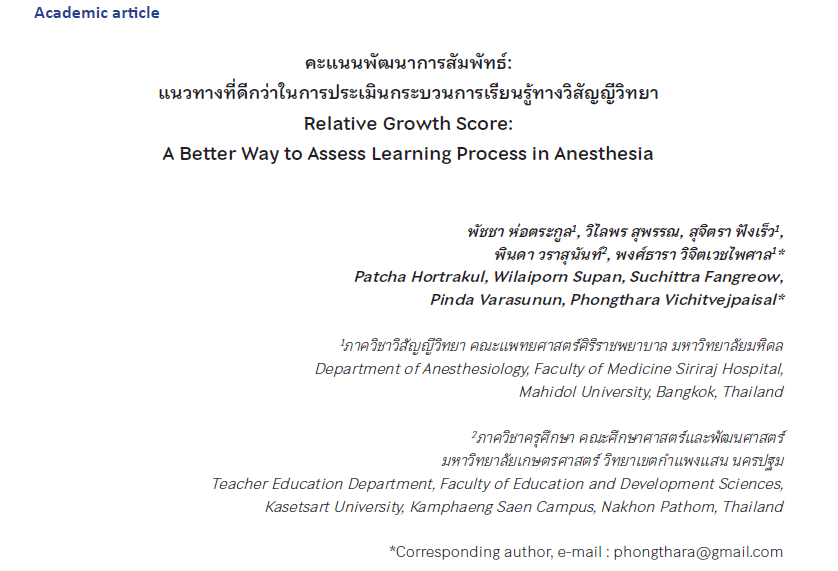Relative Growth Score: A Better Way to Assess Learning Process in Anesthesia
Keywords:
Anesthesia, Learning process, Learning assessment, Learning achievement score, Relative growth scoreAbstract
Before target student assessment, tests for norm- and criterion-referenced assessment are conducted under a table of specifications for cognitive, affective and psychomotor domains—essential steps in the learning process. These steps are well-validated for construct and content validity, reliability, objectivity, difficulty, and discrimination. Generally, achievement scores are performed for summative evaluation, while relative growth scores are considered formative scores.
In practice, relative growth scores are applied to students’ academic assessment via examination tests of parallelism of equality more than once. Then achievement scores are compared and correlated with referenced, pre-test scores. Therefore, the relative growth score is an estimated value with greater confidence that can fairly represent students’ intention, interests, and educational improvement. As a result, it is appropriate to apply in both theory and practice to residency, nurse anesthetists and medical students training programs and to those with different maturity, knowledge and clinical experience.
Downloads
References
Blondeel E, Everaert P, Opdecam E. Stimulating higher education students to use online formative assessments: the case of two mid-term take-home tests. Assessment & evaluation in higher education. 2022. Accessed November 1, 2022 ;47(2):297-312. https://www.tandfonline.com/doi/full/10.1080 /02602938.2021.1908516.
Constantinou C, Wijnen-Meijer M. Student evaluations of teaching and the development of a comprehensive measure of teaching effectiveness for medical schools. BMC Med Educ . 2022. Accessed November 1, 2022;22:113. doi: 10.1186/s12909-022-03148-6.
Citi GPS: Global perspective & solutions. Disruptive innovations V ten more things to stop and think about. 2017. Accessed November 1, 2022;3-75. http://www.citi.com/citigps.
Kaplan S. Leadership competencies for disruptive innovation. American Management Association. 2018. Accessed November 1, 2022. https://www.amanet.org/articles/leadership-competencies-for-disruptive-innovation.
Alade O, Igbinosa V. Table of specification and its relevance in educational development assessment. EJEDP. 2014. Accessed November 1, 2022;2(1):1-17. https://www.eajournals.org/wp-content/uploads/Table-of-Specification-and-its-Relevance-in-educational-development-Assessment.pdf.
Duke C, Hamidi S, Ewing R. Validity and reliability. Basic Quantitative research methods for urban planners: routledge. 2020. Accessed November 1, 2022;88-106. https://www.taylorfrancis.com/chapters/edit/10.4324/9780429325021-6/validity-reliability-carl-duke-shima-hamidi-reid-ewing.
Erlinawati E, Muslimah M. Test validity and reliability in learning evaluation.Bulletin C Eng. 2021. Accessed November 1, 2022;1(1):26-31. https://attractivejournal.com/index.php/bce/article/view/96.
Oermann MH, Conklin JL, Rushton S, Bush MA. Student evaluations of teaching (SET): Guidelines for their use. Nurs Forum. Accessed January 18, 2018. doi:10.1111/nuf.12249.
Schiekirka S, Reinhardt D, Beißbarth T, Anders S, Pukrop T, Raupach T. Estimating learning outcomes from pre- and posttest student self-assessments: a longitudinal study. Acad Med. 2013;88(3):369-375. doi:10.1097/ACM.0b013e318280a6f6.
Ryznar E, Levine RB. Twelve tips for mindful teaching and learning in medical education. Med Teach. 2022;44(3):249-256. doi:10.1080/0142159X.2021.1901869.
Leenknecht ML, Wijnia M, Köhlen L, Fryer R, Rikers SS. “Formative assessment as practice: The role of students.” Assess Eval High Educ. 2021. Accessed November 4, 2022.46(2):236–255. https://core.ac.uk/download/pdf/325953146.pdf.
Burkett T. Norm-referenced testing and criterion-referenced testing. In The TESOL encyclopedia of English language teaching. 2018. Accessed November 2, 2022;1-5. Doi: 10.1002/9781118784235.eelt0351.
นิศากร จุลรักษา. A Comparison of Relative Gain Score on the Topic of “Derivative of Function using Derivative Rules” for Freshmen of Faculty of Medical Technology via Traditional Learning, Cooperative Learning and Computer–Assisted Instruction Learning. National Research Conference. 2014. Accessed November 1, 2022 :856-865.
ศิริชัย กาญจนวาสี. ทฤษฎีการทดสอบแบบดั้งเดิม. พิมพ์ครั้งที่ 6. กรุงเทพฯ: โรงพิมพ์แห่ง จุฬาลงกรณ์มหาวิทยาลัย; 2552.
สรร ธงยศ. การประเมินพัฒนาการทั้งระบบ: การประยุกต์ใช้วิธีการเชิงปริมาณและเชิงคุณภาพ. วารสารมหาวิทยาลัยนครพนม. 2558;5(3):122-128.
Sturdevant SG, Lumley T. Statistical methods for testing carryover effects: A mixed effects model approach. Contemp Clin Trials Commun. 2021;22:100711. Accessed February 25, 2021. doi:10.1016/j.conctc.2021.100711.
Lim CY, In J. Considerations for crossover design in clinical study. Korean J Anesthesiol. 2021;74(4):293-299. doi:10.4097/kja.21165.
Gupta D. 11 Strategies for improving learning retention(2024). 2024. Accessed November 25, 2022.https://whatfix.com/blog/learning-retention/#:~:text=11%20 Strategies%20to%20Improve%20Learning%20Retention% 201%201.,in%20the %20flow%20of%20work%20...%20More%20items.
Vichitvejpaisal P, Panjamawat T, Varasunun P. A comparison of knowledge retention between online and in-class problem-based learning. South-East Asian J Med Edu. 2011. Accessed November 2, 2022;5(2):41-48. https://seajme.sljol.info/articles/10.4038 /seajme.v5i2.196.
Vichitvejpaisal P, Panjamawat T, Varasunun P. Which model is the best predictor of learning achievement: raw score, relative growth or knowledge retention score?. South-East Asian J Med Edu. 2014. Accessed November 2, 2022;8(1):66-71. https://seajme.sljol.info/articles/10.4038/seajme.v8i1.127.
Arthur K, Christofides N, Nelson G. Effectiveness of a pre-adolescent inter-generational intervention to address HIV and obesity in South Africa, using a pretest-posttest design. BMC Public Health. 2021. Accessed November 1, 2022;21:2251. doi: 10.1186/s12889-021-12228-z.
Hortrakul P, Yangan K, Phoson P, Charoensri A, Vichitvejpaisal P, Sombood P. A crossover study of English proficiency test for communication in nurse anaesthetist students. South-East Asian J Med Edu. 2020. Accessed November 1, 2022;14(2):31-37. https://seajme.sljol.info/articles/10.4038/seajme.v14i2.218.
Apidechakul P, Vichitvejpaisal P, Jirativanont T, Triyasunant N, Iramaneerat C, Udompandurak S. Crossover study in simulation-based and problem-based learning in difficult airway management. Med Ed. 2017. Accessed November 1, 2022;6(23):1-16. https://mededpublish.org/articles/6-23.

Downloads
Published
How to Cite
Issue
Section
License
Copyright (c) 2024 Chulabhorn Royal Academy

This work is licensed under a Creative Commons Attribution-NonCommercial-NoDerivatives 4.0 International License.
Copyright and Disclaimer
Articles published in this journal are the copyright of Chulabhorn Royal Academy.
The opinions expressed in each article are those of the individual authors and do not necessarily reflect the views of Chulabhorn Royal Academy or any other faculty members of the Academy. The authors are fully responsible for all content in their respective articles. In the event of any errors or inaccuracies, the responsibility lies solely with the individual authors.


